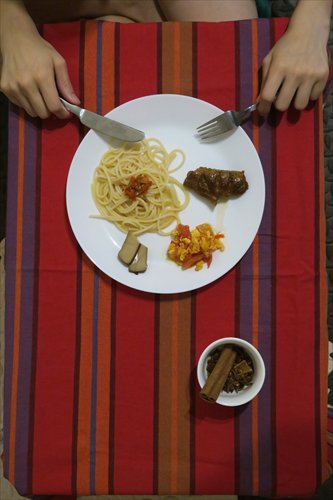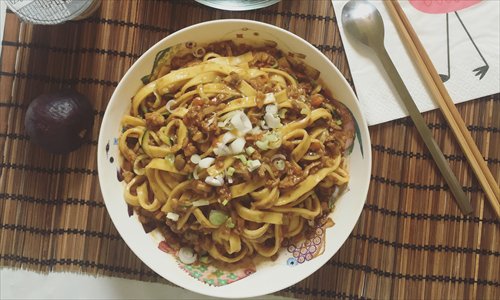People create new Western noodle dishes from Chinese cooking methods and ingredients

Spaghetti is one of several pasta noodles that are often used when creating fusion dishes from traditional Chinese meals. Photo: Li Hao/GT
Ren Wu, a Chinese student currently studying art in Turin, Italy, has been called "the pasta cook" by his friends, classmates and even people he barely knows.
Ren, 27, posted 100 pictures of pasta dishes cooked Chinese-style in 2015, in an album on douban.com, a popular social media platform in China. The album has gained popularity, especially after some public WeChat accounts for students studying in Italy and overseas shared Ren's pictures.
According to Ren, this is a popular way of cooking for Chinese students studying abroad, especially in Italy. It is not only convenient but also satisfies cravings for Chinese dishes.
Ren's devotion to cooking sets him apart.
"I've found that different types of pasta go with different Chinese recipes," he said. "I love making a small change [in the recipes] so that it leaves the person looking forward to the next day's meals more."
Italian pasta is an important part of cooking and culture in Italy, just like Chinese noodles in China. Using either type of noodle can allow for unlimited combinations of cooking methods.
As access to exotic cooking materials, foods and spices has become more convenient, tastes are getting more and more diverse and the demand for international dishes and creative fusion food is growing. With the help of chefs and experienced home-cooking enthusiasts, Metropolitan explores how to combine Western and Eastern flavors, using Chinese cooking methods and spices, to make unique pasta dishes.

Fettuccine with pork, salty and sweet sauce, scallion and cucumber is among the 100 Chinese-style pasta dishes posted online by Ren Wu. Photo: Courtesy of Ren Wu
100 different noodle recipes
Ren got bored with eating pizzas and sandwiches every day, so he bought all kinds of pasta and started his cooking experiment.
He found that spaghetti is the best choice for making Chinese "banmian," which is prepared using boiled, drained noodles mixed with sauce. He often mixes the noodles with shredded cucumber, carrot and chickpeas.
Ren said egg noodles and fettuccine are the best for soup since they hold up well, boil quickly and are quite tasty.
"All the unusually shaped pastas, including alphabet pasta, conchiglie and pipe rigate, retain a lot of sauce, so they would go well with Chinese fried bean paste or potato and beef stew," he said.
Since Ren is originally from Chengdu, Sichuan Province, his favorite dish is using spaghetti to make cold noodles in chili oil with sesame sauce, which has also proved to be popular among his Italian friends.
A Chinese diet usually pairs rice with vegetables and meat, and many Chinese people overseas, like Ren, use pasta as a substitute for rice. They even found that sometimes pasta proves to be better than the authentic Chinese noodles, since pasta does not get swollen, pasty or melt easily.
"Spaghetti doesn't stick, while Chinese noodles have to be dipped in cold water before mixing them with sauce, adding an additional step," said Ren.
Another positive of using pasta is that it is perfect for taking mouth-watering pictures for social media.
"Chinese noodles are too delicate, and you have to get them out of the water and eat them right away once they are cooked," he said.
But with pasta, Ren can just let the noodles boil in one pot and prepare his sauce at the same time. "You don't have to think about whether the noodles are melting when you are throwing your scallion, ginger and garlic in the wok," he said.
"You can take your time, choose a good filter and take a picture. But with Chinese noodles, when you are done taking the picture, the noodles would have already absorbed all the soup."

Amedeo Ferri, Chef de Cuisine of Barolo, The Ritz-Carlton, Beijing Photo: Courtesy of The Ritz-Carlton, Beijing
Finding the perfect flavor
A quick search on food blogs and recipe websites reveal tons of "Chinese-style pasta" recipes, such as stir-fried pasta, soy sauce bacon pasta and Chinese chicken spaghetti.
Yang Chunhui is the chef and national senior consultant at Lee Kum Kee, a Hong Kong-based condiment producer, which is well known for its oyster sauce and a wide range of other Chinese sauces.
He points out that it requires experimentation and practice to find the best combinations since China has such a large selection of cooking styles, which vary from region to region, with many types of noodles.
"For example, People from some regions add dietary alkali to the noodles to increase elasticity, and some add salt. There are fine dried noodles, knife-cut noodles and hand-made noodles," he said.
In terms of cooking methods, there are many ways Chinese noodles can be prepared, including noodles boiled in soup, stirred noodles with oil and sauce, sautéed noodles with meat and fried noodles in hot oil, he said.
With so many cooking methods, spices and styles to choose from, it creates a challenge trying to cook pasta the Chinese way, making experimentation key.
Yang finds macaroni among the most suitable type of pasta for Chinese cooking methods, due to its softer texture and hollow shape that allows it to hold more sauce.
Born and raised in Beijing, Yang and his family prefer the Beijing-style - sautéed noodles with minced meat in soy bean paste, replacing the Chinese noodles with spaghetti. He also likes the Beijing-style fried shredded pancake, and replaces the pancake with pasta.
He recommends making cold Sichuan-style sesame paste and using it with pasta, a great dish for hot summer seasons.
He reminds Chinese people to pay extra attention to achieve a satisfying level of doneness of the noodles. "Remember to add some cold water while the noodles are boiling, then bring them back up to a boil and repeat several times to make sure the spaghetti is well cooked," he said.
Overcoming the culinary barrier
Chen Shanshan, a food writer and nutritionist based in Shanghai and the US, told Metropolitan that Chinese people living overseas like to use angel hair, a long, thin type of pasta, in their cooking, and they also enjoy ravioli made in a Chinese-style, sometimes even replacing the ravioli skin with wonton skin.
"Since angel hair is thin but still quite dense and chewy, it can be used in making Chinese cold noodles (a type of noodles often made with cold broth, especially popular in summer), and it tastes better than using Chinese noodles," Chen said.
According to her, generally, pasta can be mixed and served with Chinese noodle sauces, but it is not suitable for making Chinese noodles with soup, braised noodles, or stir-fired noodles.
"They do not work in these dishes because they are harder, and don't absorb oil well, which is also the reason Italian pastas feature many different shapes and sizes to better accommodate different cooking methods and sauces," she explained.
Chen said although Chinese people generally enjoy Italian cuisine, it's still very challenging to cook pasta Chinese-style and make sure it caters to a majority of Chinese palates, mainly due to the texture of the pasta noodles.
According to her, Westerners want their pasta to be firm to the bite, or "al dente" (Italian for "to the tooth"); but the texture of a medium-cooked noodle is not what many Chinese prefer.
"If you cook the noodles longer, they will become too soft and pasty, which is not acceptable to many Chinese palates either," she added.
However, as the Chinese are becoming more accustomed to pasta, despite the preferential differences, the demand for more Chitalian dishes will grow, according to Chen.
Foreign attempts
Although the Chinese noodles and pasta have different origins, they are both important staple foods loved by people all over the world. There might be a variety of cooking styles, but they still share a lot of similarities. Some of the most popular dishes are even similar, such as bacon and tomato spaghetti and Chinese tomato noodles with gravy, according to Amedeo Ferri, Chef de Cuisine at Barolo, an Italian restaurant in The Ritz-Carlton, Beijing in Chaoyang district.
Ferri finds there are often more flavors in Chinese noodles. "In terms of the sauces, pasta sauce tends to highlight one single flavor, such as using the marinara sauce to highlight the freshness of the seafood, while there might be sweet and sour flavors added into the Chinese noodle sauce," he said.
At the restaurant in Beijing, Ferri applies some of the local materials, ingredients and spices when making pasta. "Using chili, rice vinegar and soy sauce gives it a bit of sweetness and freshness."
Yang has also noticed that many Westerners also like to get creative and apply Chinese sauces in their cooking, as Lee Kum Kee is expanding overseas with a distribution network spanning over 60 countries.
Such combinations have created many unexpected delicacies, he said. "For example, if you mix the black pepper sauce [from the West] and the oyster sauce [from the East], you get something that tastes wonderful."
As an Italian chef and expat in Beijing, Ferri agreed that it is very common for foreigners to experiment with the flavors around them - mixing Chinese and Western ways.
"Sometimes it turns out to be good and sometimes so-so. But it's important to experiment and find the perfect combination."
Newspaper headline: Fusion pasta